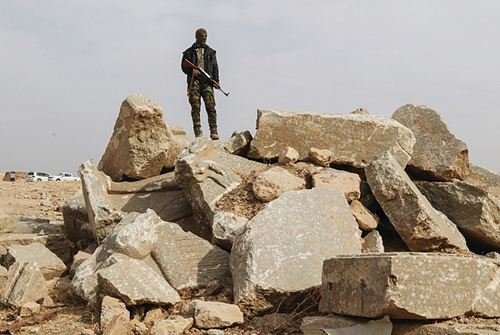Modern-day Monuments Men wanted by the British Army
UK military draws up plans for specialist unit to protect cultural heritage in war zones
Destruction by extremists at Nimrud, revealed after the ancient site was retaken by Iraqi forces in November (Image: Idris Okuducu/Anadolu Agency/Getty Images)
The British Army could be recruiting modern-day Monuments Men and Women as early as next year, The Art Newspaper understands. The ministry of defence has tasked the army with creating a specialist cultural protection unit, MPs were told during a debate in Parliament in late October. The army, as well as the navy and air force, is looking to recruit between 15 and 20 people, such as archaeologists, with the specialist knowledge that the military lacks on the front line. “For the first time since the Second World War, the UK will have a specialised unit to protect cultural property wherever its forces are deployed,” says Peter Stone, the Unesco chair in cultural property and peace at Newcastle University.
The move to create the unit is being driven by the UK government’s decision to ratify the 1954 Hague Convention for the Protection of Cultural Property in the Event of Armed Conflict. Article seven of the convention states that armed forces have “specialist personnel whose purpose will be to secure respect for cultural property and to co-operate with the civilian authorities responsible for safeguarding it”. With cross-party support, the convention could become UK law as early as next spring.
Lt Col Tim Purbrick, a British army reservist who was a tank commander during the Desert Storm campaign and is also an art dealer, has led a military cultural-property-protection working group for the past two years. “For me personally, it is as if the stars have aligned,” Purbrick says, adding: “We started with aspirations, rather than anticipations.” He stresses that no decisions have been made about the new unit’s structure or budget, but that the army will be looking to recruit “civilian practitioners” with specialist skills from the reserves. “The British Army is tasked with making recommendations, but it will be up to the ministers to make the decisions,” he says.
We reported in early 2015 that the US military has ramped up its longstanding commitment to cultural heritage protection by recruiting more heritage professionals, archaeologists and curators. After years of war in Afghanistan and Iraq, conflict in Syria and the large-scale looting of antiquities and the destruction of heritage sites by extremists, the army recognises the need for experts in the field to advise commanders and work with civilian authorities.
The UK armed forces, like the US military, consult civilian experts, but specialists in uniform are able to advise commanders on the ground during a battle or immediately after a conflict.
Before the recent campaign to liberate Mosul, in northern Iraq, from Islamic extremists, the US produced a pocket guide to the city’s heritage for Iraqi and Kurdish troops. The US State Department-funded handbook was a collaboration between several organisations, including the Smithsonian Institution and the US Committee of the Blue Shield—the so-called Red Cross of cultural heritage.
St John Simpson, the British Museum’s assistant keeper of the Middle East department, who is a specialist on Afghanistan, has briefed troops deployed to war zones. He welcomes the new move to create a specialist unit in the armed forces. He says that having specialists “embedded” on the front line means that they can say “what is appropriate or inappropriate” military action and help to prevent “accidental damage”. He adds: “They can also be the point of contact between the armed forces and institutions such as ourselves.”
The ongoing battle to retake Mosul and defeat Islamic State puts not only the ancient site of Nineveh at risk but also the medieval city of Mosul, he points out.
Corine Wegener, a cultural heritage preservation officer at the Smithsonian Institute and a retired US Army reservist who assisted staff at the National Museum of Iraq in Baghdad after it was looted in 2003, says: “We’re seeing how the destruction of cultural heritage is being used to terrorise people. We’re not [working to protect heritage] just because we want to or because we feel we have an ethical responsibility to do so. It’s the law. It also reminds people that this is what distinguishes a professional military from armed extremist groups. We protect heritage, they destroy it.”
• For more see: Why ratifying the Hague Convention matters
